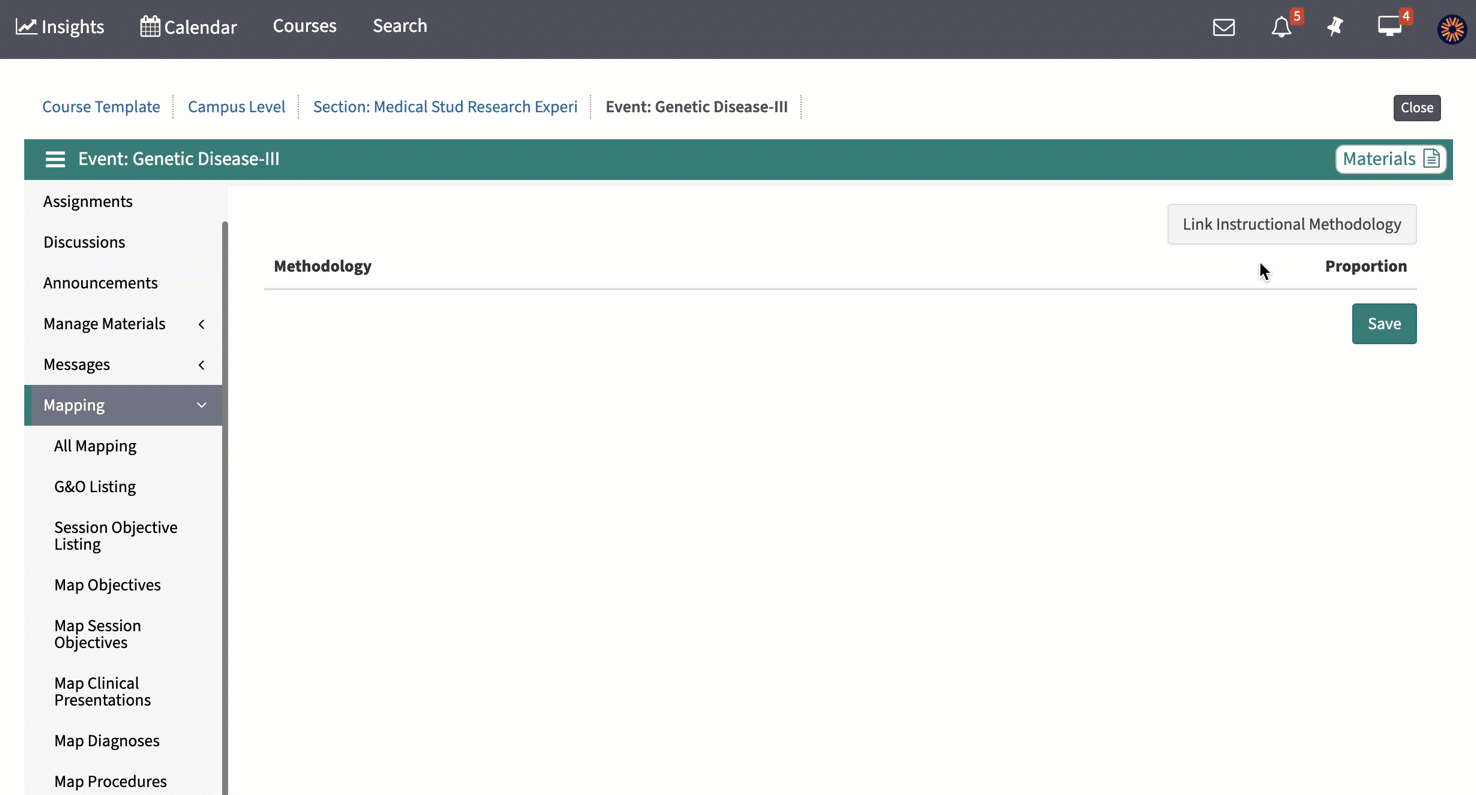Path: Calendar > Event > Mapping
At the Event Level, you can map Session Objectives directly to your Course Objectives in addition to many other mapping options.

Session Objectives are declarative statements by the Instructor describing the detail of what is to be taught in the current learning Event.
The Instructor can also link these Session Objectives to the section's Course Objectives. This is a very powerful mapping tool because it documents, with great detail, the specific content that is being taught in support of the linked Course Objectives and if appropriately mapped, Program Objectives and Competencies.
(1) Options > New
This screen is used to create a new Session Objective for the Event.

If the current learning Event is part of a linked Event, then the Session Objective will be replicated to the other linked Events.
If you are manually adding or copying Session Objectives into Leo from an external source, please strip all formatting (Keyboard Shortcuts. Mac: Cmd + Shift + V. Windows: Ctrl + Shift + V.) when pasting the text.
By stripping the format for the Session Objectives, this will avoid the creation of special characters in your Session Objectives which can cause issues when making updates.
(2) Edit an existing Session Objective
Click on the Session Objective to make any changes or delete the session objective.

(3) Link Session Objectives to Course Objectives
To Link (or map) your Session Objectives to Course Objectives take the following steps:
- click on the number in the Linked Course Objectives column
- select Link Course Objective
- choose the Course Objective to link to this Session Objective
- click Add
- repeat steps 2-4 to link as many Course Objectives as are applicable to a single Session Objective
- select Save
- go back to the report to view your updated list of Session Objectives
The purpose of this mapping is to show where Clinical Presentations are being taught in a didactic setting.
- Select the Available PET Clinical Presentation
- Check the boxes next to the G & O for this Clinical Presentation
- Click Save Selections
- Selected PET Clinical Presentation
- Click to Close window

This option allows you to specify which Diagnoses are being covered by an Event.
Depending on how your System has been configured, you may also have the option to create a new Diagnosis entry if the one you are looking for does not yet exist. If so, be careful that you do not create duplicate entries.

When you select a PET Diagnosis you will also be prompted to select the G&O that apply to the Diagnosis within the current Event.
This option lets you specify which objectives apply to the Core Problem records that have been linked to the current Event.

This is used to map Instructional Methods to an Event. You can map multiple methodologies, but one must be tagged as the Primary Method.
After adding all of your instructional methods, you should determine how much time is dedicated to each within the event. Add the appropriate percentage to each instructional method and choose Save.
Default methods can be assigned to Event Types. If defaults have been set, they will be loaded if you have not assigned any methods to an Event.
This tool maps Assessment Methods to Events.
The list of methodologies are specific to each program. The creation and assignment of Instructional Methods is controlled by screens in Course Management.
You will be prompted to specify if the assessment is Formative or Summative, and whether the particular entry is the primary assessment type for the Event.
Resources define the various tools, technology, and aids that are used in an instructional Event.

For more information refer to the article on Resources.
Themes are used to identify where a given topic, specialty, or theme is being taught throughout the curriculum. The intent of the Theme feature is to allow subject experts to manage how a Theme is being taught throughout all years of the curriculum.

Once you have mapped a learning object with a Theme it can be tracked, as part of the that Theme, via various reports and screens.
This feature will allow administrators to hide curriculum mapping from Students until after the Event.
This must be activated in the Account Manager settings. For more information refer to the article on Hide Mapping from Students.
NOTE: Faculty cannot hide mapping from Students; this needs a security access level of 70.






